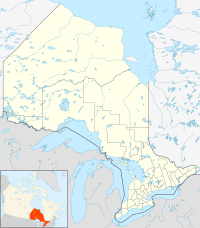Whitefish Bay 33A facts for kids
Quick facts for kids
Whitefish Bay 33A
|
|
|---|---|
| Whitefish Bay Indian Reserve No. 33A | |
| Country | |
| Province | |
| District | Kenora |
| First Nation | Northwest Angle 33 |
| Area | |
| • Land | 12.89 km2 (4.98 sq mi) |
| Population
(2011)
|
|
| • Total | 79 |
| • Density | 6.1/km2 (16/sq mi) |
Whitefish Bay 33A is a special place in northwestern Ontario, Canada. It's a land set aside for the Northwest Angle 33 First Nation, an Indigenous community. This area is located right by the beautiful Lake of the Woods, not far from a town called Sioux Narrows-Nestor Falls. It's one of three reserves that belong to the Northwest Angle 33 First Nation.
Contents
What is Whitefish Bay 33A?
Whitefish Bay 33A is officially known as an Indian reserve. In Canada, these are lands that the government holds for the use and benefit of First Nations peoples. It's a place where members of the Northwest Angle 33 First Nation live and keep their traditions alive.
Home of the Northwest Angle 33 First Nation
This reserve is one of three pieces of land belonging to the Northwest Angle 33 First Nation. This First Nation is an Indigenous group with a rich history and culture. They have lived in this area for many generations. The reserve helps them maintain their community and connection to their ancestral lands.
Life by Lake of the Woods
Whitefish Bay 33A is located on the shores of the vast Lake of the Woods. This lake is famous for its clear waters and many islands. Living by the lake offers opportunities for fishing, boating, and enjoying nature. The nearby town of Sioux Narrows-Nestor Falls provides some services and connections to other communities.
How Reserves Work in Canada
Indian reserves were created through treaties and laws in Canada. They are meant to be places where First Nations can live and govern themselves. Each reserve has its own unique history and community. The people living on reserves are Canadian citizens, but they also have special rights as Indigenous peoples.
Governance and Community
First Nations communities on reserves, like Northwest Angle 33, have their own governments. They often have a chief and council who make decisions for the community. These leaders work to improve life on the reserve. They also help preserve their culture, language, and traditions.
Land and Resources
The land on a reserve is held in common by the First Nation. This means it belongs to the whole community, not to individual people. This arrangement helps protect the land for future generations. It also supports traditional activities like hunting, fishing, and gathering.


